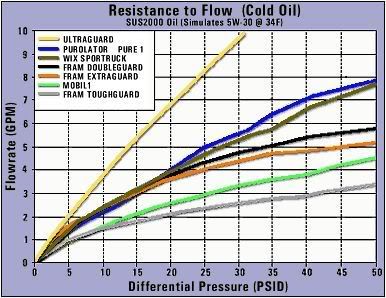In response to my request, here is what Purolator states its beta rate is on the PureONE:
Hi Katrina,
Here are the Beta Ratios for the PureOne that was requested.
Below I put the standard beta ratio chart for comparison.
Micron 5 = B4.8
Micron 10 = B50
Micron 15 = B1000
Micron 20 = B1000
---------------------------------------------------------
Standard
You would typically see
Beta Ratio Efficiency
2....................50%
10....................90%
20....................95%
75....................98.7%
100....................99%
200....................99.5%
1000....................99.9%
----------------------------------------------------------
Using the standard ratio numbers here is our PureONE.
(> = greater than; µm = microns)
B2 = below 5 µm
B10 = 6.69 µm
B20 = >8 µm
B75 = >11 µm
B100 = 11.42 µm
B200 = >13 µm
B1000 = >15 µm
I hope this isn't too confusing.
Once again, I don't get a wall of secrecy from Purolator when I need answers. Their beta rates are yet another reason why I only use the PureONE! Does anyone have this data on the Amsoil/Mobile 1/Royal Purple filters?


Hi Katrina,
Here are the Beta Ratios for the PureOne that was requested.
Below I put the standard beta ratio chart for comparison.
Micron 5 = B4.8
Micron 10 = B50
Micron 15 = B1000
Micron 20 = B1000
---------------------------------------------------------
Standard
You would typically see
Beta Ratio Efficiency
2....................50%
10....................90%
20....................95%
75....................98.7%
100....................99%
200....................99.5%
1000....................99.9%
----------------------------------------------------------
Using the standard ratio numbers here is our PureONE.
(> = greater than; µm = microns)
B2 = below 5 µm
B10 = 6.69 µm
B20 = >8 µm
B75 = >11 µm
B100 = 11.42 µm
B200 = >13 µm
B1000 = >15 µm
I hope this isn't too confusing.
Once again, I don't get a wall of secrecy from Purolator when I need answers. Their beta rates are yet another reason why I only use the PureONE! Does anyone have this data on the Amsoil/Mobile 1/Royal Purple filters?






